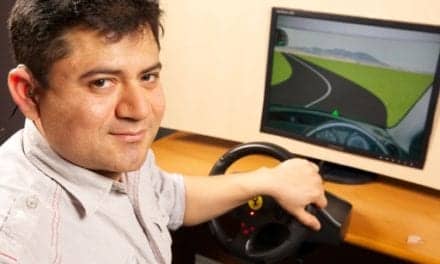Nanci Link-Ellis uses her own experiences to change the way deaf and hard-of-hearing individuals view films.

I have been deaf since I was 10 years old. I grew up in a family that was involved in the entertainment industry, and we were constantly going to the movies, seeing concerts, watching television, and listening to the newest hits on the radio. It all went over my head, but it didn’t really faze me because I didn’t know the gist of what I was missing—not until 33 years later, when I was in my 40s and experienced the miracle of a cochlear implant. That rocked my world. Nothing would ever be the same. I could now use a telephone for the first time. I now had a mission in life.
InSight Cinema, a Santa Monica, Calif-based nonprofit organization, celebrated its third anniversary November 1, and it is safe to say that no screen—large or small; film, video, or digital—is safe from being captioned in the near future. At least, not if I have anything to say about it.
InSight Cinema emerged from another deaf nonprofit organization when it grew big enough to stand on its own in November 2002. The organization partners with studios and major theater chains to distribute open-captioned (OC), first-run films to deaf and hard-of-hearing (DHH) audiences nationwide. Formerly known as Tripod Captioned Films, InSight Cinema became successful with the launch of Titanic, when Paramount gave us eight OC prints to distribute to 200 cities around the United States and Canada. It did not take me long to realize that film distribution didn’t exactly come with a “how to” manual.
I was a natural born lip reader, so I managed to go through school, graduate from college, and work in the television business by “bluff and barter.” If someone would make my phone calls, I’d type their memos; I was, and still am, the fastest typist in the West.
In the 1960s, there were no captions, note-takers, pagers, fax machines, or Internet. Back then, there was not even videotape or Blockbuster. I essentially grew up without I Love Lucy and Disney films; you can’t read the lips of animated cartoon characters.
Being in a show business environment, I had first-hand knowledge of the power of the “big screen,” but it wasn’t until I saw The Bodyguard, my first open-captioned film, that I realized what I—and some 30 million other DHH Americans—had been missing. I literally pulled the car over and cried after I left the theater. I understood every word; I knew who the characters were. It was mind blowing.
I then knew what I wanted to do with the rest of my life.
The power of that big screen is underestimated. The fact that it is one of the “ties that bind us” as a culture is irrefutable. It’s about inclusion.
I don’t come from the “litigate and legislate” mindset. It is just as easy to show studios and theaters that those with hearing loss are no different than mainstream audiences. They buy popcorn, drink soda, and play video games in the lobby just like everyone else.
You can’t take your eye off of the bottom line either. These are businesses. Their customers want a good product, convenient times and locations, and clean auditoriums. Captioning is a new and growing part of it. Thanks to such venues as gyms, sports bars, and airport visual paging systems, captioning is here to stay.
A Resounding Success
To everyone’s shock, InSight Cinema was a resounding success. I eventually approached other studios and they jumped aboard. Suddenly, we had an OC film program in place and were providing first-run feature films to deaf and hard-of-hearing audiences around the United States. In 1991, I helped the Australian government set up its own version of the OC program, which continues to run in that country today.
By the end of 2005, approximately 150 films will have played via different captioning formats on about 400 screens in the United States. Of course, this still represents only .01% of the more than 36,800 screens in the United States. Put into perspective, we—as a small band of people with no federal or state funding whatsoever—have been able to accomplish in 12 years what has taken the federal government and the US Department of Education 30 years to complete with television.
While open-captioned presentation continues to be the universally preferred format, there is also a closed-captioned system, called Rear Window Captioning, which requires equipment installed in a theater auditorium and a reflector cup that is used by the patron at their seat for individual viewing. OC projectors have emerged to replace the 35 mm prints, and on the horizon for 2006 are private and personal captioning systems that will synchronize with digital projectors. This will be a “Holy Grail” for Baby Boomers and those with hearing loss in the coming digital revolution.
Now that InSight is settling in for the long run, our sights are on digital formats and other applications for access. This interest in captioning does not stop with just television and film. I’m now going back to my roots in theater; I got my BFA degree at Ohio University in Athens, Ohio, and now I will finally get an opportunity to use it. I saw the Rolling Stones in concert and finally heard some of the words to their songs—God, I wish I had had captioned lyrics on my Blackberry to sing along with Mick Jagger.
Open-captioned theater is alive and well in the United States, and InSight is just now getting into strategic alliances and partnerships with groups such as Project DATE (Deaf Audience Theatre Experience) at the Ahmanson Theatre in Los Angeles, the Kennedy Center in Washington, DC, and other access groups that present captioned performances of musical theater and dramatic productions.
Captioning is a crucial element in accessible entertainment. I honestly believe that the overall dip in attendance at movie theaters has something to do with loud soundtracks and the diminishing hearing of which most people are unaware. Of those individuals with a hearing loss, 95% do not understand sign language. People with severe to profound loss or those suffering from tinnitus or those who are just plain aggravated in large groups prefer captioning. It enhances their hearing. Contrary to what some audiologists might think, it doesn’t stop them from listening. I know it helps; I’ve been going down that road for a long time now.
People who do not use sign language are constantly e-mailing us for information about where they can find something—anything—captioned in their area, when they are on vacation, etc. There is a dearth of product.
We all know that hearing loss by its very nature means a communication obstacle. We have barely scratched the surface. It’s all about finding out what is available and where and when it is going to be held. We are the only Web site devoted to different forms of captioned entertainment around the United States.
Each Friday, e-mails are sent out to everyone who has signed up to receive them in all 50 states, announcing all of the upcoming open-captioned films in each of the respective areas. More than 30,000 e-mails go out each week with about 300 listservs participating and forwarding the information to other groups, schools, agencies, friends, and interested parties.
Beyond theaters, InSight intends to expand its Web site to include opera, captioned houses of worship, museums, lecture series, and any other public event. The more people with hearing loss see others using hearing aids and other products, the more their subconscious will accept the possibility. The more we encourage people to request captioning services, the more available it will become.
It is time to bring hearing loss out of the closet. If you can talk about formerly unmentionable topics, losing your hearing shouldn’t be taboo. We have eye examinations, Pap smears, PSA tests, and mammograms on an annual basis. We get our teeth cleaned twice a year. Women get a bone density test after age 50. Why can’t a hearing test be mandatory every 5 years after 40?
Among Generation Xers, 16% have already suffered hearing loss, and 78 million Baby Boomers are entering retirement next year. Hearing loss is going to have a major impact on everything from business to entertainment to risk management, and everything in between. Maybe it’s time to show business how good hearing means a better bottom line. If using a Bluetooth earpiece means you are cool and high tech, then why can’t wearing digital hearing aids have the same appeal? We have to make it okay to enhance the quality of our hearing sound in 2006.
Nanci Linke-Ellis is the executive director of InSight Cinema. She has worked as a television producer, and is a member of the Academy of Television Arts & Sciences, the Director’s Guild of America, Women In Film, Entertainment Industry Council, and the Foundation of the Motion Picture Pioneers, which became the Motion Picture Pioneers Assistance Fund in 2002.





